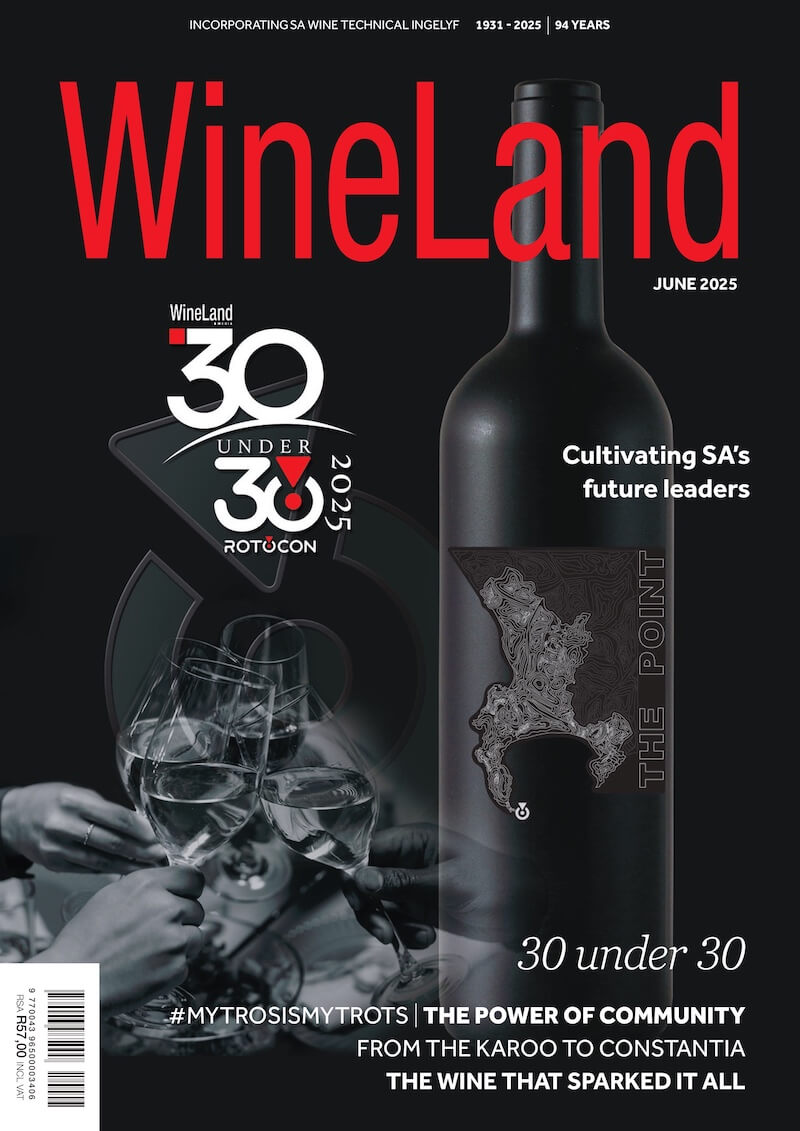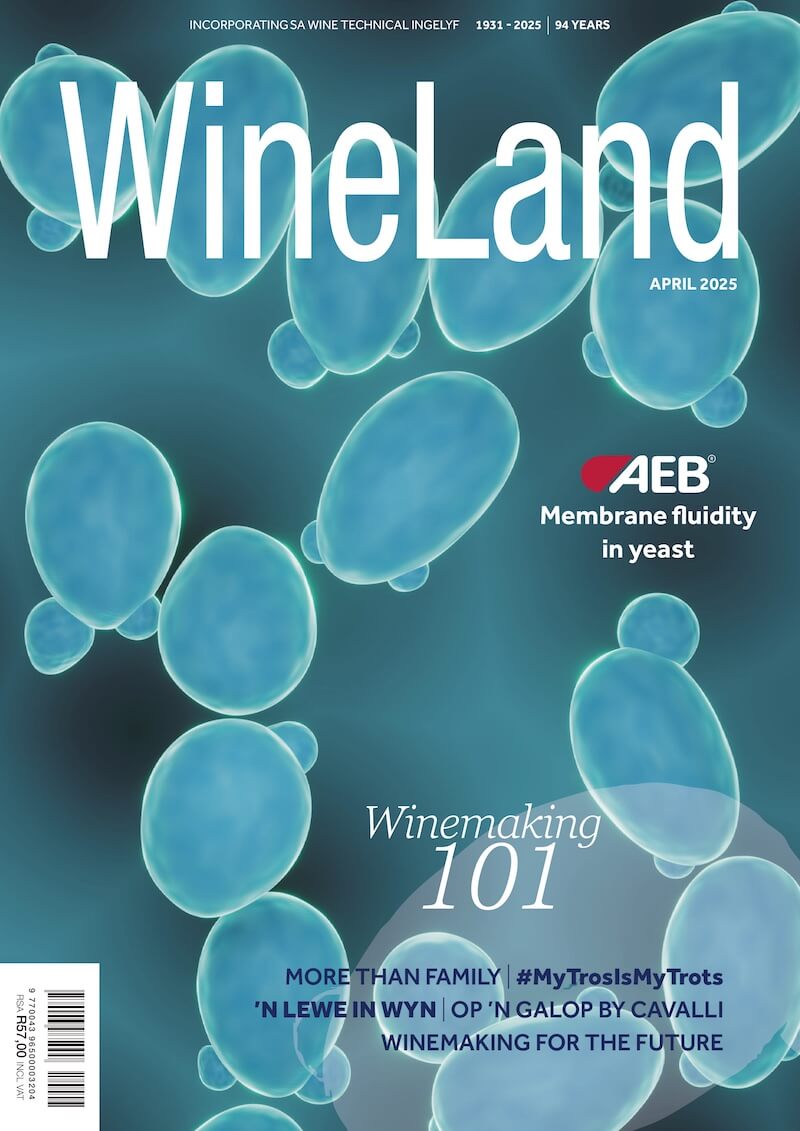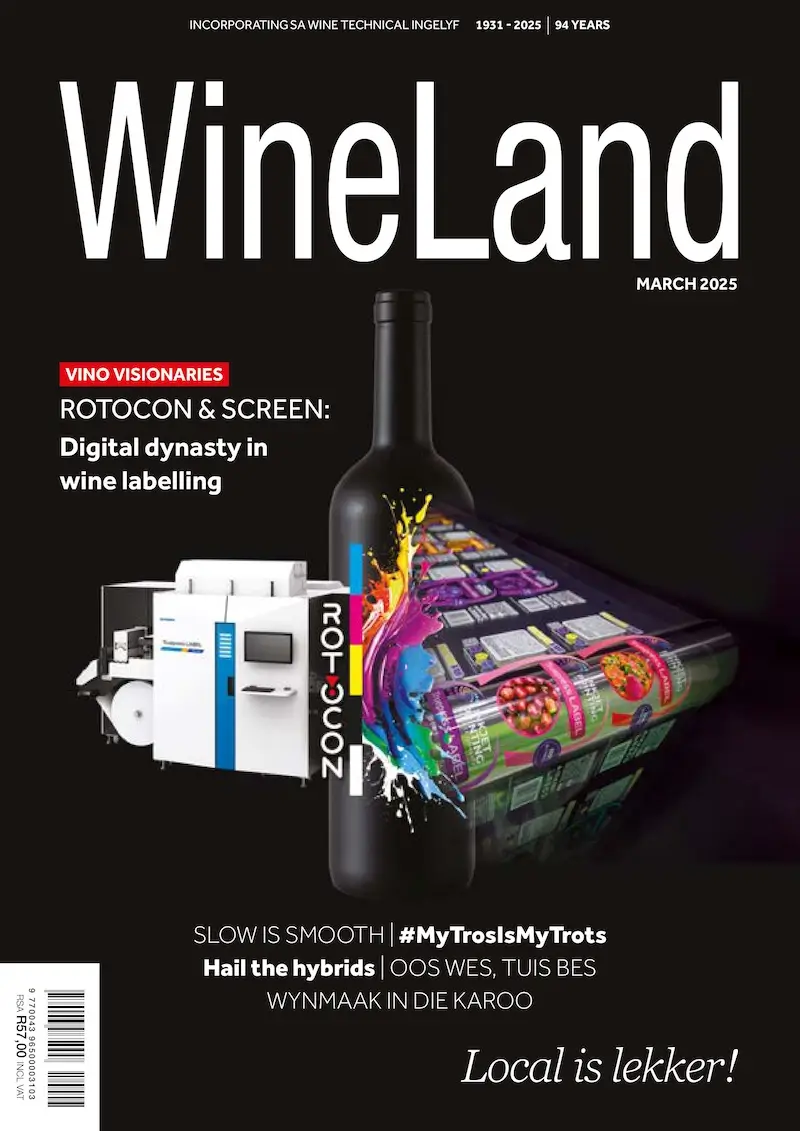The use of cover crops on berms is notably applied in the drier vineyard regions, like Agter-Paarl, Swartland and Darling. The advantages thereof have been well researched, with Archer and Saayman (2018) emphasising that it is particularly beneficial for the development of fine roots in the shallower soil layers (photo 1), as well as deep roots. In contrast, mechanical clean cultivation and growing weeds (or permanent cover crop) impeded the development of the vine’s interception roots in the shallower soil layers. The detrimental effects were only observed later in diminished shoot growth and subsequent lower yield.
Fourie (2021) found in the Coastal Region that a mulch that was formed by mulching in the work row, decreased the irrigation requirement of a vineyard by up to 50 mm. In these cases the cover crop was terminated before bud break.

PHOTO 1. In this vineyard the interception roots developed very well in the shallower soil layers under a straw mulch.
Mulching improves the soil organic carbon content over time (Fourie, 2021), and according to Saayman (2016), natural nitrogen supply should be sufficient to meet the vines’ need on soils with higher carbon contents (≥0.7% for light and ≥0.9% for heavier texture soils). It is a very good approach to vine nutrition in drier areas where rainfall can be unpredictable and the application of conventional fertilisers therefore very difficult. Fertilisers that lie on the soil for a long time, volitalise and the nutrients are thus lost. Organic material also serves as nutrient source for micro-organisms which improve soil health.
The use of mulches therefore holds multiple advantages, like water conservation, suppression of weeds, soil improvement in terms of carbon content and microbial activity, and ultimately improved yield and quality in water-scarce areas (photo 2).

PHOTO 2. The hay on this vineyard’s berm promotes root development, and suppresses evaporation losses and summer weeds.
The type of material used, must be fibre-rich to retain its shape for an extended period in the sun, wind and weather. The most common option is to spread out one small bale of hay between three vines; approximately 1 000 bales per hectare. At a purchase price of R17 to R20 per bale it is a staggering amount, even if it lasts for two to three years. The cost of buying organic materials like hay or wood chips for establishing a mulch, is currently the biggest limiting factor preventing its widespread application. Most producers currently applying this practice, produce their own hay and other organic materials.
Alternatives
The cultivation of cover crops in the work row is a generally common practice and we currently have commercial species that can be successfully cultivated under various conditions. According to Fourie (1994), a good cover crop stand can produce up to seven tons of dry material. Species like triticale in particular is known for good fibre production. In 2020, results from the Gen-Z cover crop demo sites (Barenbrug seed) in the Paarl area found that different cover crop combinations were able to yield seven to 10 tons of dry material per hectare. It is thus possible to produce large amounts of dry material in the vineyard at relatively low cost. Pruned cuttings is a further source of material, and at an average vigour, 0.6 kg dry shoots are produced per metre of cordon, thus around two tons per hectare.
Mechanisation in the vineyard has advanced significantly over the past few years and this has seen the introduction of implements for finely cutting the cover crop and shoots into a mulch and spreading it on the berm. An example of this can be seen in photo 3.

PHOTO 3. This mulcher is an example of an implement that chops up cover crop and pruning shoots and spreads the mulch on the berm. (Photo: Francois Viljoen.)
In this way a mulch is placed on the berm, but the work row is cut to a stubble (unless the cover crop can form regrowth), which can in turn lead to summer weed problems in the row. This practice is not recommended for dry areas, as evaporation of water in the work row will increase. The cover crop’s fibre content is also not optimally developed using this approach, and if cut too finely, it will not last long on the berm. Nutrients are however released faster from the green, mulched cover crop.
Producers have also been performing trials with living mulches over the last few years. Medics, already established early in the year on the berms, are mostly used for this. Photo 4 shows a vineyard where medics had been established early autumn on the berms, and photo 5 shows the same vineyard in springtime.

PHOTO 4. A medics cover crop was established early in the winter on the berms of this vineyard in the Stellenbosch area. (Photo: Emma Carkeek.)

PHOTO 5. Medics naturally dying off on the berm after setting seed.
The medics species grow until spring, past the vines’ budding period, and it is important to check the vines for any symptoms of competition. It is consequently not a good option for dryland vineyards.
Possible scenarios and cost of the options
The following table indicates possible scenarios where mulching can add value to yield and quality. The purchase cost of materials is expensive, but the materials can also be produced by producers themselves, which will lower the cost.
Possible scenario | Treatment | Cost (Rand per ha) |
| Treatment of weak patches, due to e.g. soil compaction, in a vineyard. | Purchase and application of compost (100 m3 per ha). | R63 000 every two to three years. |
| High-value vineyards in water-scarce, drier areas. | Purchase and laying out of weed-free hay (1 000 small bales per ha). | R30 000 every three to four years. |
| High-value vineyards in water-scarce, drier areas. | Purchase and spreading of wood chips (150 m3 per ha). | R40 000 every four to five years. |
| Vineyards with higher nutritional needs in areas with low summer weed pressure. Sufficient water available to meet irrigation requirement. | Sowing of cover crop in the work row, mechanical chopping and spreading on berm. | R1 900 per year. |
| Vineyards with sufficient water available for irrigation and high summer weed pressure. | Establishment of medics on the berm. | R1 600 per year. |
Mulch at planting
Mulching can be employed as early as the planting stage. The use of black plastic strips is very effective and Van der Westhuizen (1980) found that the vines had three times more roots than the uncovered vines over a depth of 80 cm. It was further found that this advantage persisted for up to five years after establishment. The cane and crop mass also improved in cases where a cover was used. Myburgh (2020) also found that soil water was significantly higher under the covered berm during the growing season, compared to the middle of the row. The major drawback of plastic is that it is very expensive and difficult to ultimately remove from the vineyard. A very exciting technology is biodegradable plastic (photo 6), which disappears completely after a few years. The cost of establishment is notably higher than the conventional plastic strips (approximately four times more expensive), but it does make sense when considering the labour required to remove the plastic from the vineyard.

PHOTO 6. This first-leaf vineyard was established with biodegradable plastic. The producer will be satisfied if it lasts for two years, which at this stage appears likely.
Summary
Mulching on berms has many advantages, but the cost of purchasing materials is becoming too expensive for most wine grape producers. By self-cultivating the organic material and placing it on the berms, or establishing a living mulch, this practice is made more cost effective and a viable consideration for more producers.
– For more information, contact Hanno van Schalkwyk at hanno@vinpro.co.za.
Click here to get your copy of WineLand Magazine and here to subscribe to our newsletter.













